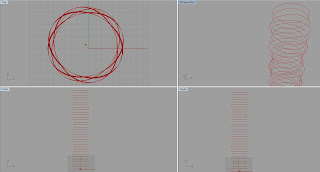http://www.mediafire.com/?ym2pt5ymrepcow1
My PDF poster, grasshopper and Rhino file, and plagiarism form.
http://www.mediafire.com/?9u4ze2q8vhuzvkw
Iterations and grasshopper flowgraph
Wednesday, 28 March 2012
Assignment 1.
12 iterations
TEXT in PDF
THE RHOMBUS
A rhombus is a parallelogram with four equal sides. It is the most distinct geometry in a diamond compared to other geometries. Rhombus can be said to be a fairly simple shape as the shape can be obtained by drawing four lines. In Rhino, a 3D rhombus can be formed quite easily by using lines. However, my way of doing it starts from creating a sphere and then changing the polygon counts to come up with the rhombus.
VARIOUS SHAPES
Other than rhombus, there is much other geometry in a diamond, from the image, different geometries can be seen clearly as the reason for having the grids alignment is to make each geometry appear clearly. The different geometries formed depends on the adjustments on the number sliders in grasshopper. The number sliders determine the polygon count for objects.
From the top view of the diamond object, the different geometries that can be seen are such as triangles, rectangles, circles, rhombus, trapeziums and prisms. Those are the standard ones, still there are unique polygon shapes that could not be unidentified as there are geometries formed with lines.
REFLECTION
The reflection of light through the diamond produces another type of geometry which is line. Through my research and images, I have noticed that light happens to give out a very simple yet sophisticated geometry. The different rays transmitted through the diamond gives out very uniform reflections. And those rays and reflection is simply done with lines. By using grasshopper, I showed how lines are being produced when the sun hits the diamond.
RENDERINGS
I have only chosen a few parts of my object to render as I think for my idea, it is about geometries and geometries can best be seen with grid lines and wireframe viewport. I rendered the front view of the diamond; reason was to shows what kind of geometries are there in the diamond. The different geometries of the diamond have different shades of colour after rendering. This is also due to the polygon counts in each geometry.
MULTIPLE LINES
Lines, the most interesting geometry among all others, are one dimension geometries. It is the most important geometry in order to create other geometries as other geometries are derived from lines. A line does not seem magnificent on its own but when there are multiple lines, interesting and unique forms of geometry can be produced. The image shows a geometry which is created by multiple lines and turns out to be a circular shape with lines evolving it.
SUMMARY
This assignment, I did an object, which is a diamond and worked on the different geometries of a diamond. And experimenting with grasshopper to use lines to form a circular-shaped geometry that surrounds the outbound of the diamond. How shapes can be formed using one of the geometries (lines) of a diamond. Other than that, I incorporated the idea of light, and the reflection of the diamond with and see how lines are projected.
Wednesday, 21 March 2012
Wednesday, 14 March 2012
Tuesday, 13 March 2012
Tutorial
Create A Diamond Solid. The Basics
RHINO GRASSHOPPER - PATTERNING WITH 2 ATTRACTOR POINTS
http://designreform.net/2008/07/grasshopper-patterning-with-2-attractor-points
Images
 |
| Crystal Light Separation |
 |
| Crystalline Structure |
 |
| Light Rays. Balancing |
 |
| Primordial Red Road |
 |
| Rainbow Spectrum |
Images above shows different ways of light, reflection and how light is transmitted onto different objects and elements. The play of light shows many outcomes, from a very consistent result to various patterns produced. It shows that it does not only end with a systematic way but also different forms of geometry for example the forth image Primordial Red Road. It shows similarity to the DNA bond structure which interprets geometry in a very complex way.
Week 2 task. Research.
Book Title: Crystallography: An Introduction ( Third Edition )
Author: Walter Borchardt-Ott
1. Introduction
Author: Walter Borchardt-Ott
1. Introduction
References: Walter Borchardt-Ott, 2011, Crystallography: An Introduction
Week 2 task. Research on the chosen theme.
Title: The Diamond Theorem by Steven H.Cullinane
Important parts:
1. colour interchange symmetry
Important parts:
1. colour interchange symmetry
2. Line diagrams
If I change the pairs of the columns, quadrants or rows, the pattern changes as well. This applies to the concept of the light rays and reflection. Different rays will be produced depends on the direction of light coming through.
This is a link to this web page. Allows you to click on the columns and rows and a pattern will be made according to what you've choose from.
The Diamond 16 Puzzle by Steven H. Cullinane
Example of pattern produced
Wednesday, 7 March 2012
Tuesday, 6 March 2012
Week 1 task. The 3 themes
Blue-heart Diamond.
The reason of choosing this image is simply because I like it's unique look and how it is transformed from a rough diamond to this very fine and delicate heart-shaped diamond after cutting and polishing. It looks like there is system and grids formed within.
Rock- crystal
The forms varies yet it shows similarity. It gives people the feeling of a very strong energy that the crystal has.
Sun rays.
This image shows rays that is uniform and the rays complete in a circle.
Image credits:
http://famousdiamonds.tripod.com/blueheartdiamond.jpghttp://www.galleries.com/Rock_Crystal/rock_cry.jpg
http://www.pikespeakphoto.com/images/views/sunrays.jpg
Subscribe to:
Comments (Atom)








































